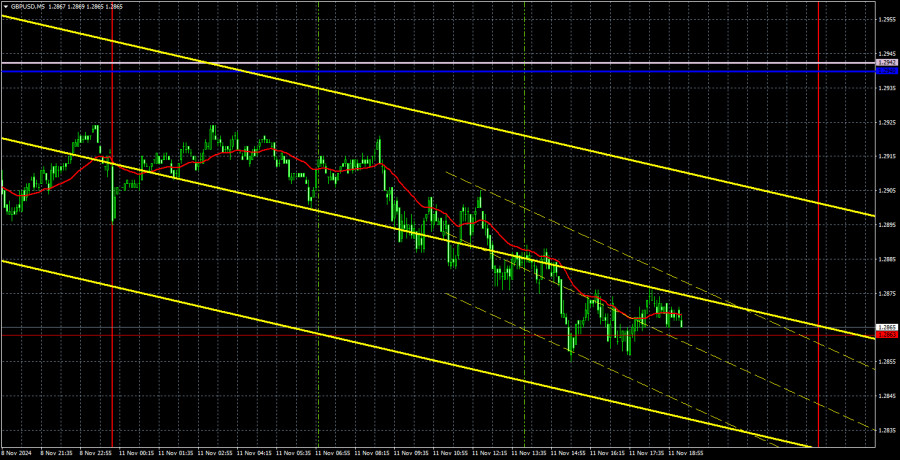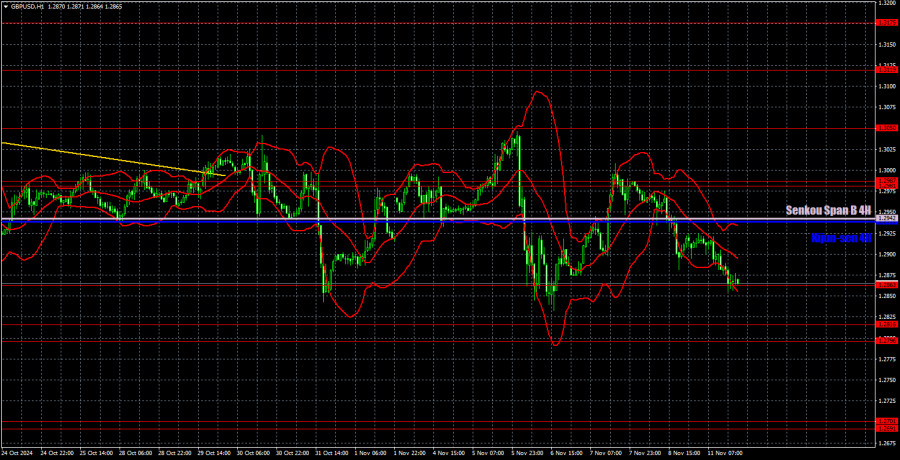

The GBP/USD pair also declined on Monday but stayed within the horizontal channel, with its lower boundary around 1.2850. Throughout 2024, we've consistently highlighted the pound's "super-resistance" to the dollar. When the pound rises, it does so more strongly than the euro, and when it falls, it declines less steeply than the euro—relative to volatility. While the euro plummets, the pound has remained stagnant for weeks. However, we believe this won't last. The same factors pushing the euro downward also affect the pound. The Bank of England will lower rates just like the European Central Bank and the Federal Reserve—it's only a matter of time. Over the next six months, the BoE may reduce rates slowly with pauses, but eventually, it will accelerate rate cuts as other central banks near the end of their easing cycles.
Meanwhile, reports from the Fed increasingly suggest they may not lower rates to the "neutral" level. Concerns about Trump's inflationary policies might prompt preemptive actions. Why lower rates too far to face rising inflation that forces hikes again? This gives the dollar additional justification for sustained strength. As for the pound—it has been lucky so far, but luck doesn't last forever.
There were no trading signals on Monday. However, on Friday, the price broke below the Senkou Span B and Kijun-sen lines, suggesting a potential decline on Monday. In a flat market, these lines are weaker, but the wide channel means breaking Ichimoku lines still results in decent moves.
COT Report
The latest Commitments of Traders (COT) report for the British pound highlights fluctuating sentiment among commercial traders in recent years. The red and blue lines, representing the net positions of commercial and non-commercial traders, frequently intersect and remain near zero. The most recent downtrend coincided with the red line moving below the zero mark. The red line is above zero, and the price has breached the critical level of 1.3154.
The latest COT report shows that the non-commercial group closed 11,900 BUY contracts and opened 9,400 SELL contracts, reducing their net position by 21,300. Despite this, the market remains hesitant to sell the pound in the medium term.
The fundamental backdrop continues not to justify long-term pound purchases. Meanwhile, the currency has a realistic chance of resuming its global downtrend. However, the weekly time frame shows an ascending trendline, so expecting long-term pound depreciation is premature until this line is breached. The pound has been rising against most expectations in the medium term.
GBP/USD 1-Hour Analysis
The GBP/USD pair maintains a bearish outlook in the hourly time frame. The upward trend has been canceled, and further declines in the pound seem inevitable—both strong and prolonged. After the first corrective wave ended, the second and third began immediately. There's no reason to expect a medium-term dollar decline. While the pair remains in a horizontal channel, it still leans toward further downward movement.
For November 12, we highlight the following important levels: 1.2796-1.2816, 1.2863, 1.2981-1.2987, 1.3050, 1.3119, 1.3175, 1.3222, 1.3273, 1.3367, 1.3439. Senkou Span B (1.2942) and Kijun-sen (1.2939) lines can also be sources of signals. Set a Stop Loss to breakeven once the price moves 20 pips in the intended direction. Remember that Ichimoku indicator lines may shift throughout the day, which should be considered when identifying trading signals.
On Tuesday, no significant events are scheduled in the UK or the U.S., suggesting the pound may remain within the sideways channel. A rebound from the lower boundary near 1.2863 could trigger a new wave of growth.
Chart Explanations:Support and resistance levels: thick red lines around which movement may end. They are not sources of trading signals.
Kijun-sen and Senkou Span B lines: Ichimoku indicator lines transferred from the 4-hour to the 1-hour timeframe. These are strong lines.
Extreme levels: thin red lines where the price previously rebounded. They are sources of trading signals.
Yellow lines: Trend lines, trend channels, and other technical patterns.
Indicator 1 on COT charts: The net position size for each category of traders.